Spacious Palisade Gives Hyundai Luxury SUV
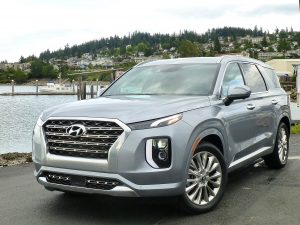
The 2020 Hyundai Palisade made easy work of a trip through the mountains from Coeur d’Alene, Idaho, to Bellingham, Wash.
By John Gilbert
COEUR d’ALENE, Idaho
Hyundai’s SUVs are selling at a fantastic rate, but the company also has heard from consumers with three or more kids: “We want more room.” Even the most loyal Hyundai buyers have to turn to Toyota, Ford or General Motors if they want a larger, three-row SUV, because Hyundai’s fleet consists of midsize and smaller.
Hyundai has swiftly addressed those concerns with its largest SUV, called the Palisade.
A few years ago, I couldn’t have guessed what a Palisade actually is, but living on Minnesota’s North Shore of Lake Superior, you get used to the large, substantial, rock cliffs that rise straight up from the scenic shoreline in a spectacular ridge that runs from Duluth to beyond the Canada border. One of the neatest North Shore tourist sites is the comparatively unknown turnoff to “Palisade Head.” The view from atop Palisade Head is fantastic, and some adventurers bring rock-climbing gear and conduct rappelling exercises over the edge and 200 feet straight down.
“Our vehicle names generally are taken from Southwest or Western locations,” said Mike O’Brien, Hyundai’s vice president of product planning. “This time, we wanted to match the character of a fortress, something substantial. Palisade represents a slice of a cliff, and symbolizes strength.”
O’Brien has never been to Palisade Head, but he was addressing automotive media types summoned in several waves to Coeur d’Alene, a jewel of a mountain resort spot located right in the narrow northern part of Idaho, for the first driving impressions of the 2020 Palisade.
The Palisade replaces the Santa Fe XL as the largest SUV from the South Korean company, and while its bold grille doesn’t resemble anything seen on the Santa Fe, Tucson or Kona, it breaks new styling ground while accumulating all of the almost futuristic features of those smaller siblings, while aiming higher. Hyundai’s history of building safe, strong vehicles that over-achieve is commendable, but now there is a vehicle for those wanting more luxury, and room.
The Palisade could alter Hyundai’s image because of its remarkable luxury fittings. “We’ve focused on premium design and materials,” said O’Brien. “It’s a new image for us.”
However, Hyundai won’t exactly be departing from its reputation of providing high-value, bargain vehicles because of its surprisingly modest price. SUVs with the size and features of the Palisade are often up to twice Palisade’s price, which starts at $31,580 for the base SE. At $33,500, the SEL upgrades to accept all sorts of feature packages that can add another $10,000. The top Palisade Limited model starts at $44,700, and it, too, can add price with some amazing option packages. The Limited I road-tested hit a total of $47,605, but at that its equipment made it pretty special. AWD is standard on the Limited but can be ordered on any model.
“We have strong loyalty to our sedans, like the Sonata, Elantra and Accent, but subcompact SUVs have become the largest segment with midsize SUVs a close second,” said O’Brien. “Sixty-five percent of our total sales come from SUVs.”
With 10 new or substantially redesigned models introduced in the last year, Hyundai has had 10 consecutive months of increased sales over the previous year, and CEO Brian Smith said that while the industry is down 5 percent, Hyundai is up 5 percent.
Our press test-drive included stunning scenery, going more than 100 miles south, to Moscow, Idaho, where we had lunch at the Lodgepole Restaurant — the fish and chips featured Alaskan halibut! — and back, along some scenic, twisty mountain roadways. It was a well-devised route, but I was able to set up a way to get an extended test, after our wave ended at the fabulous Coeur d’Alene Resort.
A Palisade Limited AWD joined me for a memorable daylong drive from Coeur d’Alene westward, past Spokane and then away from the freeway up Hwy. 2 to the Grand Coulee Dam, then to the Chief Joseph Dam, and northward to Winthrop, a neat tourist-intense little Central Washington town, and finally onward, to Bellingham, Wash., and the Pacific Ocean, where I spent a few days visiting our younger son, Jeff. In all, that trip covered 495.5 miles — all on the same tankful of regular gas. I calculated over-EPA 28.1 miles per gallon despite the terrain up, down and through the Cascade Mountains.
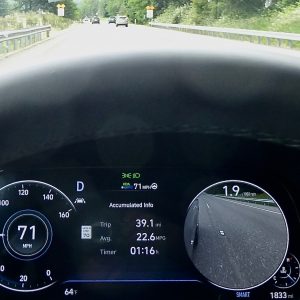
Signal to change lanes, and the speedometer or tach switches to a rear-view camera view of the lane you’re headed for.
Some of the features are refined versions of those Hyundai does very well on such SUVs as the Santa Fe, Tucson and Kona, such as the lane departure warning, lane-keep assist, and lane-centering, plus the excellent radar adaptable cruise control. A new trick is the Palisade’s ultra-helpful instrument panel. If you’re in the middle lane of a 3-lane freeway, and you flick the turn signal to get three blinks to signal a lane change, for example, the large tachometer on the right changes instantly, to a large, round image from a rear/side camera that immediately shows you that the lane is clear. Or not.
Fantastic for entering freeways, too. Otherwise, you can stick with the three-panel navigation screen, which can be adjusted from a panoramic map to a smaller map, with driver information in the adjacent segments.
Another unique feature is the intercom, which lets the driver speak uninterrupted to kids in the back two rows who may have become mesmerized by their audio options. The need for space on the console led to drive-by-wire shift switches instead of the usual shift lever, to save considerable room on the center console. The mode switch allows you to switch from Smart, to Sport, to Comfort, to Eco, or to Snow, and to AWD lock, fitting whatever your driving requires.
Less apparent is the built-in anti-skid control that uses over 50 inputs to predict the conditions for slippage before you actually slip, making it a predictive instead of reactive system. Along with the auto-leveling rear suspension, driving involvement has steering-wheel paddles to control the 8-speed automatic with manual control.
Chief designer Chris Chapman drew a sketch of how the Palisade came to life, to what he calls “personalization” of incorporating a concept into the actual design. As his drawing developed, the key features of the Palisade showed through: balanced on all four wheels, the “C” pillars sloped rearward to the top of the rear wheel-well; the side contours veering away from each other and then meeting again in harmony; the headlights, foglights, driving lights and tail-lights all with an artful design and piercing LED potency; the “shoulders” of the upper sides of the occupant compartment have a minimizing slope to lower the side-window “biceps” just a bit — to put the muscle closer to the wheels, Chapman explained.
“Early on and throughout, that piercing quality became something like an emerging predator, coming up out of the water,” said Chapman.
When a designer gets on a roll, you learn to not interrupt him with needless questions. You simply look for and appreciate the subtle touches, like the three scallops in the rear fascia of the skid plate, with the dual exhaust pipes nestled asymmetrically into the right one.
“It’s a different design,” Chapman acknowledged. “But we’re not doing Russian dolls here, where each one fits inside the other and they all look the same. We wanted to differentiate from the Kona and Santa Fe, and we stressed ergonomics, fit and finish.”
With that, he clicked the projector to replace the Russian dolls pictured with an image of chess pieces, each a different shape and form. The king, of course, is the Palisade.
For structural strength, O’Brien pointed out that the Santa Fe XL graded out to 27.8 in torsional rigidity, and while the all-new Ford Explorer — one of Palisade’s top targets — came in at 27.1, the new Palisade is up to 34.4. To be fair, the 2020 Explorer has 25 percent high-grade steel, but it is aluminum intensive. Hyundai always has featured substantial amounts of high-grade steel, and the Palisade is made up of 59 percent high-strength steel, from Hyundai’s own steel plant. The engineers have found a way to hot-stamp the high-strength steel to improve its rigidity even more.
The Palisade platform is solid enough to feel stiff but not harsh in driving, and rising from that floor is a hoop structure surrounding the passenger compartment, which has been strengthened too. Focus on strengthening the structure included even models with sunroofs, which normally weaken the rigidity. The body was designed to incorporate sound-deadening foam panels under the floor and foam injections into the roof pillars, successful in nearly eliminating wind and road noise.
The low stance and firm structure are coupled with MacPherson strut front and multi-link rear suspensions to handle road fluctuations for the stiff body.
The interior of the Palisade seems closer to full-size than mid-size, but performance of a big SUV is as important as interior space. Hyundai engineering takes care of that, too, with the corporate 3.8-liter V6 delivering 291 horsepower at a peak of 6,800 RPMs, and 262 foot-pounds of torque at 5,200. The price sheet shows it achieves 19 city and 24 highway in EPA fuel economy estimates, but I was able to get it up to 28.1 mpg on my personal trip, up and down mountainsides.
O’Brien explained that the familiar engine has been refined and now combines Atkinson Cycle and Otto Cycle operation, which are opposites in how they adjust valve opening and closing schemes, and they work seamlessly together. “That allows us to get both economy and power,” he said.
The 4,400-pound Palisade AWD also can tow 5,000 pounds in all forms, competing well with the Highlander, Pilot, CX-9, and Explorer. The Explorer is a rear-drive platform, the Palisade front, so when you switch the drive mode to “eco,” you have the efficiency and traction of a front-wheel-drive vehicle. As usual, Hyundai likes to carry its “fight above its weight class” theme, which, because of its interior space, could challenge Yukon, Tahoe, Cadillac SRX and even the Volvo XC-60 and XC-90.
To me, the Palisade drives more like a smaller SUV than one that has so much interior room, and more agility is always a good thing. A unique push-button system makes the second row slide, recline, or flip its backrest forward for ease of entry to the third row, and that third row will surprise adults with how comfortably appointed and roomy it is. It comes with a second-row bench seat, or two captain’s chairs to seat eight or seven. Palisade offers 18 square feet of storage space behind the third row, and it expands greatly when you lower the third, and maybe second, rows.
Many manufacturers are going to assorted artificial leather seat surfaces, and a lot of them are very nice. But the Palisade goes with real Nappa leather, complementing the attention to detail on the doors, dashboard, and even the speaker faceplates is.
With everything folded down, I’m guessing 6-footers could unroll a pad and sleep back there on a long trip. I prefer a resort, but turning the Palisade into a compact mini-motorhome only enhances the pleasure of a trip that could go through the rugged mountains of Idaho and Washington. Or even the North Shore of Minnesota.


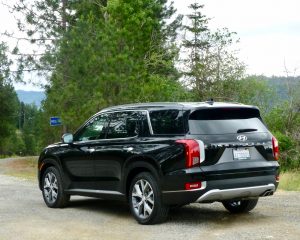
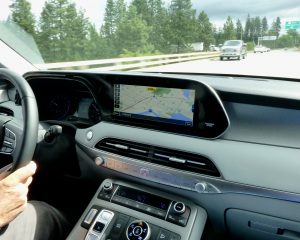
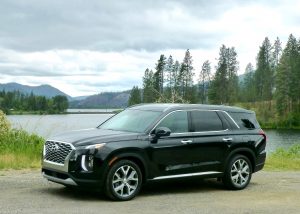

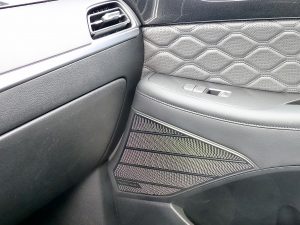

 John Gilbert is a lifetime Minnesotan and career journalist, specializing in cars and sports during and since spending 30 years at the Minneapolis Tribune, now the Star Tribune. More recently, he has continued translating the high-tech world of autos and sharing his passionate insights as a freelance writer/photographer/broadcaster. A member of the prestigious North American Car and Truck of the Year jury since 1993. John can be heard Monday-Friday from 9-11am on 610 KDAL(www.kdal610.com) on the "John Gilbert Show," and writes a column in the Duluth Reader.
John Gilbert is a lifetime Minnesotan and career journalist, specializing in cars and sports during and since spending 30 years at the Minneapolis Tribune, now the Star Tribune. More recently, he has continued translating the high-tech world of autos and sharing his passionate insights as a freelance writer/photographer/broadcaster. A member of the prestigious North American Car and Truck of the Year jury since 1993. John can be heard Monday-Friday from 9-11am on 610 KDAL(www.kdal610.com) on the "John Gilbert Show," and writes a column in the Duluth Reader.